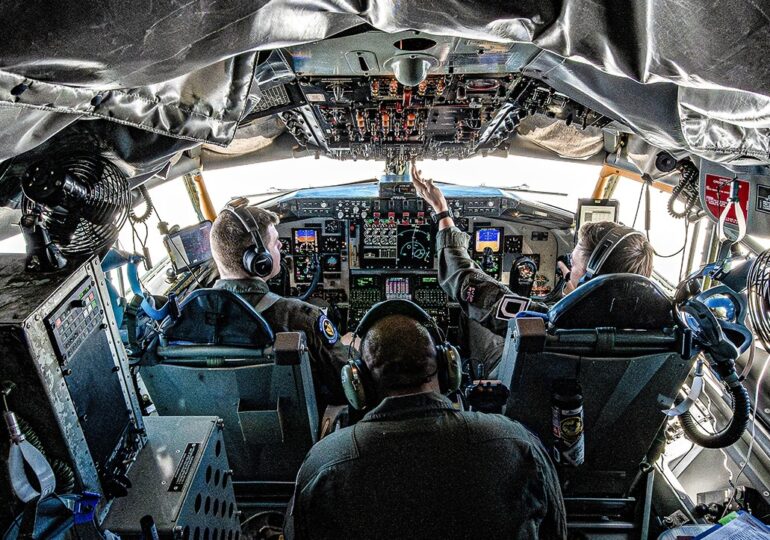NATO surveillance aircraft E-3 have been monitoring the war in Ukraine from the very beginning. The crew members have noticed a change in the aerial element of the conflict.
The crew of this NATO surveillance aircraft may not be able to see every detail of the battles in Ukraine from a cruising altitude of 9,000 meters, but they still have a surprisingly clear picture of the battlefield.
From up there, above Eastern Europe, NATO's airborne surveillance crews operating Alliance's E-3 Sentry aircraft have been monitoring Russia's aerial warfare evolution since the beginning of the war in Ukraine.
In the early months of the war, the aircrews watched as Russian warplanes bombed the frontlines. Now, aircraft rarely cross Ukrainian airspace, largely replaced by missile and drone attacks, as both sides rely more on air defense and long-range firepower, reports Business Insider.
What is seen above Ukraine now
At the beginning of the conflict, "there was a lot of activity," said Captain Jasper, a Dutch surveillance controller monitoring airspace and ground, aboard the E-3 aircraft during a recent mission over Eastern Europe, in support of the NATO Baltic Sentry operation.
But as the frontlines froze and the war became more static, there was "less activity with the planes." "That's what we saw," he said.
In the early weeks of the invasion, Russian planes and helicopters were frequently seen in the Ukrainian sky, flying deep into the country to support advancing forces, albeit often inadequately. However, losses and effective Ukrainian air defense have reduced Russia's efforts.
The war then shifted eastward, where Russia could launch missiles at Ukraine or allow its bombers to fire relatively safely. Both sides have deployed such strong air defenses that NATO crews watching from above could see the change - pilots from both sides have stopped flying within the range of anti-aircraft batteries, and Russian airstrikes have moved further away.
The sky above Ukraine has become a battlefield of counteraction, not of aerial domination. Neither side controls the sky, so Russia and Ukraine hit enemy targets from a distance. And the E-3 surveillance crews have seen the difference.
NATO's "eyes" in the sky
The E-3, a modified Boeing 707/320 passenger aircraft, can detect hostile aircraft, ships, and missile launchers from a distance. It has a 360-degree rotating radar dome that can see over 480 kilometers in the air and on the ground, as well as high-tech sensors that, unlike ground stations, are not restricted by terrain or the curvature of the Earth.
The Airborne Warning and Control System, or AWACS, can also track allied assets and interact with them. Data collected by the aircraft can be easily distributed in real-time to NATO aircraft, ships, or command centers, providing critical situational awareness to allies during war or peacetime.
The E-3 is not equipped with weapons but provides situational information, coordination, and visibility that extend NATO's radar horizon by hundreds of kilometers and make it difficult for an adversary to hide movements or attempt surprise attacks, enhancing deterrence.
The AWACS fleet also tracks how the battlefield in Ukraine has changed. Captain Jasper stated that airpower was a significant factor at the beginning of the war, but it has slowed as the war transitioned from maneuver-based battles to a war of attrition, and the frontlines became more static.
"What we see are more ISR flights - surveillance and reconnaissance flights - and there is not as much air activity in Ukraine," he explained. The officer recalled how the crew could track on computer screens as aircraft took off, flew towards the frontlines, and returned, a sign that a bombing operation had ended.
Captain Donny Demmers, a Dutch public relations officer who was allowed to share his full name, stated that aircraft now avoid getting too close to the frontlines, as Ukraine and Russia use sophisticated air defense systems that threaten enemy aircraft.
More deterrence
NATO received its first E-3 in the early 1980s, and in the following decades, the small but capable fleet flew in support of numerous missions and conflict operations, including over North America, Europe, and the Middle East.
The illegal annexation of Crimea by Russia in 2014 marked a turning point for the AWACS fleet, which began to record increased activity in Eastern Europe. After Moscow's large-scale invasion of Ukraine in 2022, NATO intensified its air patrols to better monitor Russian activities and deter any aggression on the eastern flank of the North Atlantic alliance.
Major Ben, an American officer responsible for allocating E-3 fighter aircraft, in charge of coordinating with other aircraft, stated that since 2022, NATO's air policing missions in Eastern Europe have shifted from sporadic to constant.
"We fly more, we provide more deterrence," explained the major, who, like other members of the multinational crew discussed by Business Insider journalists, could only be identified by his rank and first name for security reasons.
T.D.

